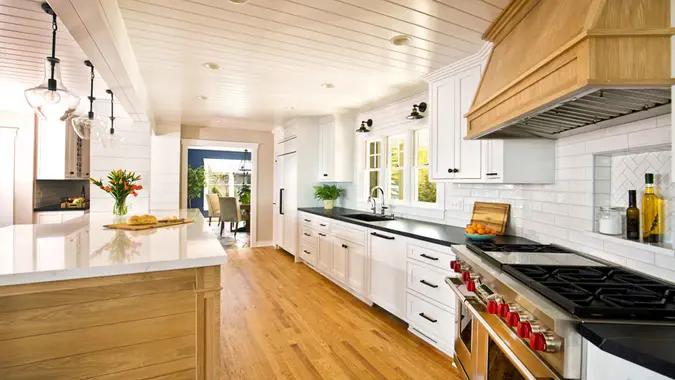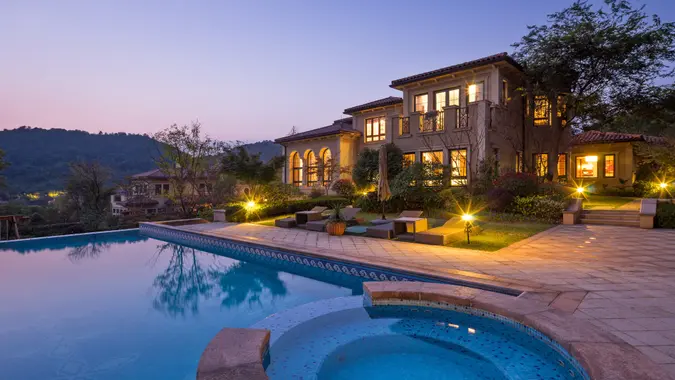This New Home Trend Could Save Homebuyers Money — Check It Out

Commitment to Our Readers
GOBankingRates' editorial team is committed to bringing you unbiased reviews and information. We use data-driven methodologies to evaluate financial products and services - our reviews and ratings are not influenced by advertisers. You can read more about our editorial guidelines and our products and services review methodology.

20 Years
Helping You Live Richer

Reviewed
by Experts

Trusted by
Millions of Readers
Home prices are influenced by a wide range of factors — including location, neighborhood comps, condition and features — but size plays a major role as well. The price per square foot can often tell you more about how home values are trending than median or average prices.
Learn More: Become a Real Estate Investor for Just $1K Using This Bezos-Backed Startup
As Realtor.com noted in a recent report, the median price of U.S. homes for sale in June 2024 was little changed from the previous year at $445,000. But the median price per square foot rose by 3.4%, which indicates that the “inventory of smaller and more affordable homes has grown in share,” according to Realtor.com senior economist Ralph McLaughlin.
Indeed, the latest “US Residential Architecture and Design Survey” from John Burns Research & Consulting found that about one-quarter of new home projects in 2023 were downsized to cut costs. This year, designers are four times more likely to plan for even smaller homes.
An increase in smaller homes should benefit house hunters in the form of lower prices. But because consumers don’t want to sacrifice the number of bedrooms, bathrooms or other living spaces just to make homes smaller, designers need to get creative.
Maybe the biggest trend — or at least the one that has gotten the most attention — is that homes now have fewer hallways. Removing hallways decreases the number of interior walls and frees up more living space, according to Mikaela Arroyo and Jenni Nichols, who co-authored the design survey report.
“Instead of shrinking rooms to reduce overall home size, a common tactic among our architectural designers was to eliminate unnecessary circulation space,” Arroyo and Nichols wrote. “Essentially, we’re ‘Tetris-ing’ the functional rooms together, avoiding wasted square footage on non-functional areas like hallways.”
While not all home buyers are happy with the elimination of hallways (partly because hallway walls tend to make homes quieter) there’s no denying that smaller, hallway-free homes have lowered prices.
An increase in budget-friendly homes priced in the $200,000 to $350,000 range outpaced all other price categories over the past five months, Realtor.com reported. In June, homes for sale in this price range rose by 50% from the previous year. The upshot is that buyers have “way more homes to choose from at a friendly price range” at a time when mortgage rates remain high.
A single-family home newly under construction had a median 2,140 square feet of floor space in the first quarter of 2024, according to U.S. Census Bureau data. That was down from 2,256 square feet a year earlier.
Fewer hallways aren’t the only design changes. Here are some other recent trends listed by John Burns Research & Consulting Survey:
- Smaller primary bathrooms, primary bedrooms, kitchens, garages, outdoor spaces and storage spaces.
- An increase in “flex space” that creates more nooks and niches in homes.
- A divergence of entry-level designs for young, first-time buyers and move-down designs for older buyers.
Although the main motivation behind smaller homes is to bring down prices, they also have other benefits.
“I work with plenty of buyers who downsize to avoid the maintenance and upkeep associated with larger homes,” Cindy Allen, a real estate agent with Texas-based DFW Moves, told Realtor.com. “Lower heating and cooling costs are also a bonus.”
Meanwhile, most modern homebuyers don’t need nearly as much space as previous generations, according to Bruce Ailion, a real estate agent and attorney with Re/Max Town and Country in Georgia.
“Years ago, we had televisions that were the size of large moving boxes, and we had stereo equipment with a turntable, tape player, and speakers the size of 10-year-olds,” Ailion told Realtor.com. “Today, the TV is flat against the wall, and all our music is in a smartphone in our back pockets.”
 Written by
Written by  Edited by
Edited by 

























